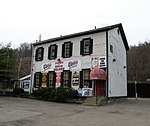Fort Robert Smalls
1863 establishments in PennsylvaniaAfrican Americans in the American Civil WarBuildings and structures demolished in 1930Demolished buildings and structures in PennsylvaniaDemolished buildings and structures in Pittsburgh ... and 4 more
Forts in PennsylvaniaPennsylvania in the American Civil WarPittsburgh metropolitan areaRedoubts
Fort Robert Smalls was a Civil War redoubt built by free blacks for the defense of Pittsburgh in 1863.It was named in honor of Robert Smalls, a man who escaped from slavery in Beaufort, South Carolina with his crew and their families by capturing a Confederate transport ship and piloting it to the safety of a Union blockade around the harbor of Charleston, South Carolina in 1862.
Excerpt from the Wikipedia article Fort Robert Smalls (License: CC BY-SA 3.0, Authors).Fort Robert Smalls
Devlin Street, Pittsburgh
Geographical coordinates (GPS) Address Nearby Places Show on map
Geographical coordinates (GPS)
| Latitude | Longitude |
|---|---|
| N 40.414722222222 ° | E -79.960555555556 ° |
Address
Devlin Street
Devlin Street
15203 Pittsburgh
Pennsylvania, United States
Open on Google Maps








